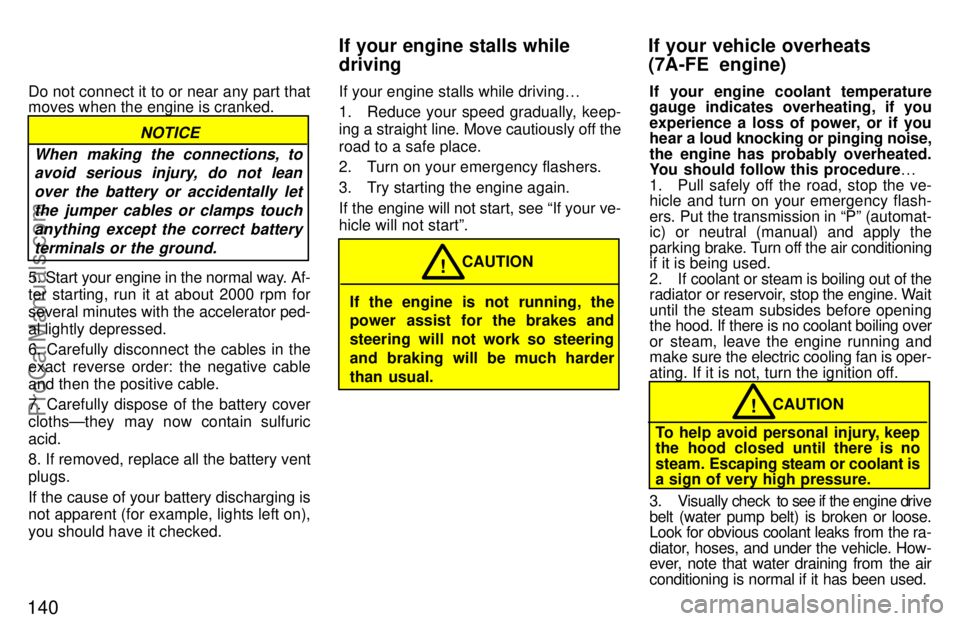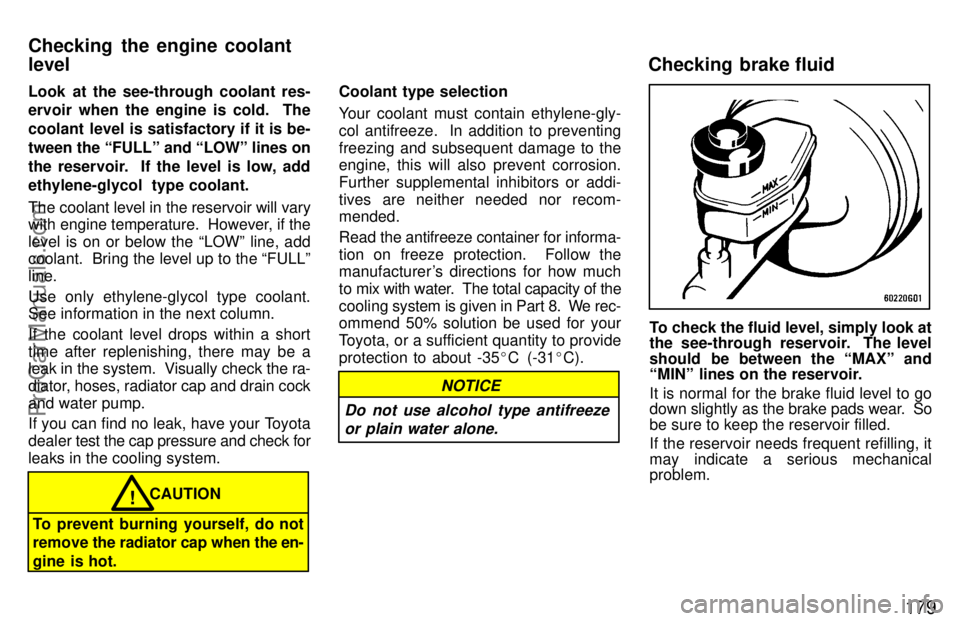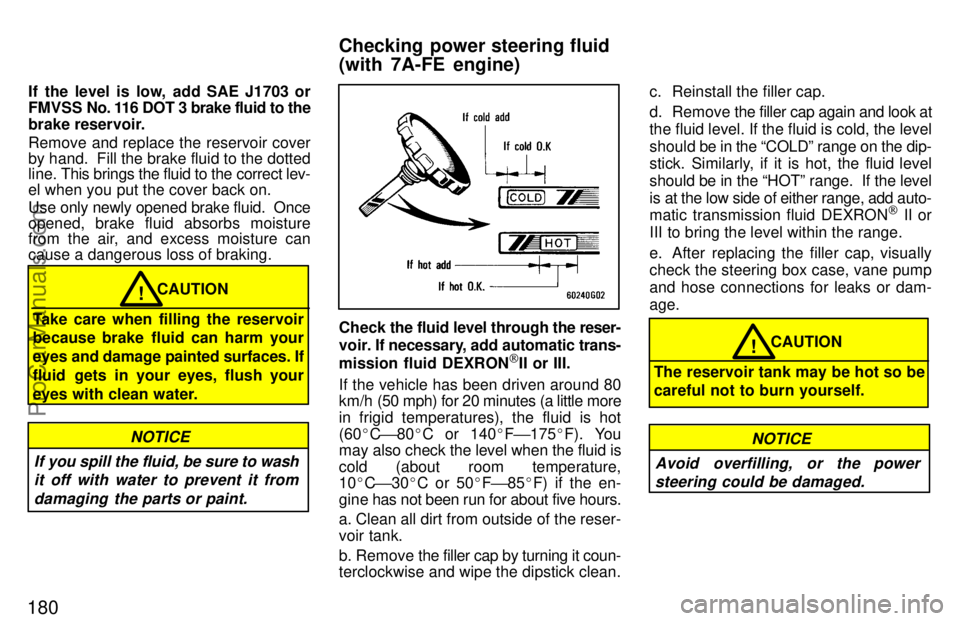Page 146 of 218

140
Do not connect it to or near any part that
moves when the engine is cranked.
NOTICE
When making the connections, to avoid serious injury, do not lean
over the battery or accidentally letthe jumper cables or clamps touchanything except the correct batteryterminals or the ground.
5. Start your engine in the normal way. Af-
ter starting, run it at about 2000 rpm for
several minutes with the accelerator ped-
al lightly depressed.
6. Carefully disconnect the cables in the
exact reverse order: the negative cable
and then the positive cable.
7. Carefully dispose of the battery cover
clothsÐthey may now contain sulfuric
acid.
8. If removed, replace all the battery vent
plugs.
If the cause of your battery discharging is
not apparent (for example, lights left on),
you should have it checked. If your engine stalls while driving
0
1. Reduce your speed gradually, keep-
ing a straight line. Move cautiously off the
road to a safe place.
2. Turn on your emergency flashers.
3. Try starting the engine again.
If the engine will not start, see If your ve-
hicle will not startº.
If the engine is not running, the
power assist for the brakes and
steering will not work so steering
and braking will be much harder
than usual. CAUTION
!
If your engine coolant temperature
gauge indicates overheating, if you
experience a loss of power, or if you
hear a loud knocking or pinging noise,
the engine has probably overheated.
You should follow this procedure
0
1. Pull safely off the road, stop the ve-
hicle and turn on your emergency flash-
ers. Put the transmission in Pº (automat-
ic) or neutral (manual) and apply the
parking brake. Turn off the air conditioning
if it is being used.
2. If coolant or steam is boiling out of the
radiator or reservoir, stop the engine. Wait
until the steam subsides before opening
the hood. If there is no coolant boiling over
or steam, leave the engine running and
make sure the electric cooling fan is oper-
ating. If it is not, turn the ignition off.
To help avoid personal injury, keep
the hood closed until there is no
steam. Escaping steam or coolant is
a sign of very high pressure. CAUTION
!
3. Visually check to see if the engine drive
belt (water pump belt) is broken or loose.
Look for obvious coolant leaks from the ra-
diator, hoses, and under the vehicle. How-
ever, note that water draining from the air
conditioning is normal if it has been used.
If your engine stalls while
driving
If your vehicle overheats
(7A-FE engine)
ProCarManuals.com
Page 185 of 218

179
Look at the see-through coolant res-
ervoir when the engine is cold. The
coolant level is satisfactory if it is be-
tween the FULLº and LOWº lines on
the reservoir. If the level is low, add
ethylene-glycol type coolant.
The coolant level in the reservoir will vary
with engine temperature. However, if the
level is on or below the LOWº line, add
coolant. Bring the level up to the FULLº
line.
Use only ethylene-glycol type coolant.
See information in the next column.
If the coolant level drops within a short
time after replenishing, there may be a
leak in the system. Visually check the ra-
diator, hoses, radiator cap and drain cock
and water pump.
If you can find no leak, have your Toyota
dealer test the cap pressure and check for
leaks in the cooling system.
To prevent burning yourself, do not
remove the radiator cap when the en-
gine is hot.
CAUTION!
Coolant type selection
Your coolant must contain ethylene-gly-
col antifreeze. In addition to preventing
freezing and subsequent damage to the
engine, this will also prevent corrosion.
Further supplemental inhibitors or addi-
tives are neither needed nor recom-
mended.
Read the antifreeze container for informa-
tion on freeze protection. Follow the
manufacturer 's directions for how much
to mix with water. The total capacity of the
cooling system is given in Part 8. We rec-
ommend 50% solution be used for your
Toyota, or a sufficient quantity to provide
protection to about -35 �C (-31� C).
Do not use alcohol type antifreeze
or plain water alone.
NOTICE
To check the fluid level, simply look at
the see-through reservoir. The level
should be between the MAXº and
MINº lines on the reservoir.
It is normal for the brake fluid level to go
down slightly as the brake pads wear. So
be sure to keep the reservoir filled.
If the reservoir needs frequent refilling, it
may indicate a serious mechanical
problem.
Checking brake fluid
Checking the engine coolant
level
ProCarManuals.com
Page 186 of 218

180
If the level is low, add SAE J1703 or
FMVSS No. 116 DOT 3 brake fluid to the
brake reservoir.
Remove and replace the reservoir cover
by hand. Fill the brake fluid to the dotted
line. This brings the fluid to the correct lev-
el when you put the cover back on.
Use only newly opened brake fluid. Once
opened, brake fluid absorbs moisture
from the air, and excess moisture can
cause a dangerous loss of braking.
CAUTION
Take care when filling the reservoir
because brake fluid can harm your
eyes and damage painted surfaces. If
fluid gets in your eyes, flush your
eyes with clean water.!
If you spill the fluid, be sure to wash it off with water to prevent it from
damaging the parts or paint.
NOTICE
Check the fluid level through the reser-
voir. If necessary, add automatic trans-
mission fluid DEXRON
[II or III.
If the vehicle has been driven around 80
km/h (50 mph) for 20 minutes (a little more
in frigid temperatures), the fluid is hot
(60 �C ' 80 �C or 140 �F ' 175 �F). You
may also check the level when the fluid is
cold (about room temperature,
10 �C ' 30 �C or 50 �F ' 85 �F) if the en-
gine has not been run for about five hours.
a. Clean all dirt from outside of the reser-
voir tank.
b. Remove the filler cap by turning it coun-
terclockwise and wipe the dipstick clean. c. Reinstall the filler cap.
d. Remove the filler cap again and look at
the fluid level. If the fluid is cold, the level
should be in the COLDº range on the dip-
stick. Similarly, if it is hot, the fluid level
should be in the HOTº range. If the level
is at the low side of either range, add auto-
matic transmission fluid DEXRON
[ II or
III to bring the level within the range.
e. After replacing the filler cap, visually
check the steering box case, vane pump
and hose connections for leaks or dam-
age.
CAUTION
The reservoir tank may be hot so be
careful not to burn yourself.!
Avoid overfilling, or the power steering could be damaged.
NOTICE
Checking power steering fluid
(with 7A-FE engine)
ProCarManuals.com